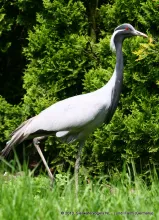
Demoiselle Crane (Anthropoides virgo)
Naamgeving
- Nederlandse naam:
- Jufferkraanvogel
- Engelse naam:
- Demoiselle Crane
- Duitse naam:
- Jungfernkranich
- Franse naam:
- Grue Demoiselle
- Wetenschappelijke naam:
- Anthropoides virgo
Taxonomische indeling
- Orde:
- Gruiformes
- Familie:
- Gruidae
- Onderfamilie:
- Gruinae
- Geslacht:
- Anthropoide
Beschrijving
- Uiterlijke kenmerken:
The Demoiselle cranes are one of the smallest crane species. It's slightly smaller than the common crane but has similar plumage.
Male:
The male has a black head, neck and breast with a pale grey back. The wings are pale grey with black primary feathers at the edges. The male has also two white stripes along his head made up of longer plumes. The legs are black and the beak is grey with an orange tip.Female:
The female is similar to the male, but slightly smaller.Juvenile:
Juvenile cranes are duller in colouration.
- Gedrag:
Generally walks slowly while foraging, but sometimes makes quick movements (e.g. to catch insects) or runs. Large flocks forage in cultivated fields and sometimes damage cereal and legume crops. They use their short bills to graze in a manner similar to geese.
Juveniles remain with their parents. In captivity, parents feed insects to their young. Parents tend their chicks for at least seven to eight weeks; the family remains together at least until flocks form in autumn, and may leave on migration together with their parents. In captivity, parents often tend on chick each.
Maten en Gewicht
- Lengte man:
- De man (woerd) van de Demoiselle Crane heeft een lichaamslengte van ongeveer 85-100 centimeters. De vrouw (pop) heeft een lichaamslengte van ongeveer 85-100 centimeters.
- Gewicht man:
- Het mannetje weegt ongeveer 2200-2800 gram. Het vrouwtje weegt ongeveer 2100-2500 gram.
Het gewicht is notoir variabel en kan alleen als indicatie worden gebruikt!
- Notitie:
Can be kept in relatively small aviaries. Mainly found on dry ground; even if water is accessible. A pool preferably should be available for bathing. Can be maintained on a pellets mixture with added protein. Will catch and eat insects, mice and small birds.
Generally need protection from severe winter weather. Cope well with the northern European climate but in winter need a good shelter with a thick straw bed to protect their feet from frost; they should be shut into this at night in winter. Provide a dry, draught-free shelter so the birds can use this if they wish to avoid cold, wet weather.
Both broodies and artificial incubators can been used for incubating the eggs.
Chicks can be hand-reared using micro pellets, fine-chopped lettuce, hard boiled egg yolk and raw minced beef, supplemented with minerals and vitamins, all offered from the tip of a pointed wooden stick, with food offered four times a day 8 am to 9 pm; The chicks would start self-feeding by a day old, but would be hand fed for several days. Ones the chicks started eating more ("clearing their dishes between feeds", poultry starter crumbs can also be provided. Each chick can be kept in a 25 cm x 55 cm pen or rearing tray, the concrete floor being covered by hessian sheeting providing a non-slip surface and easily replaced and washed. Initially the brooders can be partitioned to ensure the chicks could not go too far from the heat lamps. By one month of age each chick has a 25 cm x 55 cm area, and by seven weeks they can bee mixed in an outdoor paddock during the day and shut into a shed at night.
Prefers to nest in a secluded location. Early egg loss can be followed by laying of replacements. In captivity, if the clutch is removed as soon as it is complete, the cranes may re-lay after 10-18 days; one pair laid up to eight eggs in a season. Incubation begins after the first egg has been laid.
- Breeding:
- Het vrouwtje Demoiselle Crane legt doorgaans zo'n 2 Oval, sometimes long oval, smooth not glossy; buff to olive-grey, variably spotted and streaked dark brown or red-brown eieren het broeden duurt 27-29 dagen.
- Ringdagen:
- Aanbevolen passende ringmaat voor de Demoiselle Crane is 16 mm.De gesloten pootring kan alleen aangebracht worden bij een jonge crane van ongeveer 18 dagen oud.
- It doesn't matter what leg that you band, but it's good to have a consistent system. Suggested: Left leg = Female, Right leg = Male
- Onderhoudsvoeder:
-




The Lundi Crane Regular is much more than just an animal feed. Your pets will love the food.
- Wetgeving:
- Europese soort
- Toepassing:
Het is niet verboden om deze vogels te houden die van nature in Nederland voorkomen, op voorwaarde dat deze vogels in gevangenschap zijn geboren; nakweek dus. Deze vogels zijn voorzien van een gesloten pootring. Het is wel verboden om deze vogels te houden die in het wild gevangen zijn. Alleen bepaalde instanties, zoals vogelasiels en vogelhospitalen, zijn bevoegd om jonge en gewonde wilde vogels te houden. Deze bescherming van vogels wordt vormgegeven door schadelijke handelingen te verbieden zoals:het doden, verwonden, vangen, bemachtigen en met het oog daarop opsporen van vogels (art. 9 Flora- en faunawet); het opzettelijk verontrusten van vogels (art. 10 Flora- en faunawet);het beschadigen, vernielen, uithalen, wegnemen en verstoren van nesten, holen of andere voortplantings- of vaste rust- of verblijfplaatsen van vogels (art. 11 Flora- en faunawet);en het zoeken, rapen, uit het nest nemen, beschadigen of vernielen van eieren van vogels (art. 12 Flora- en faunawet).
